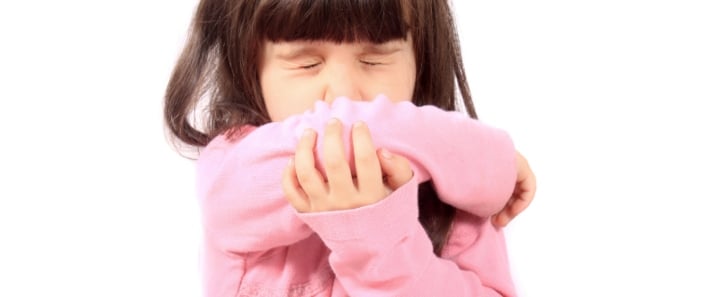Amyra Patel, 3 years old, had multiple bouts of sneezing and a runny nose every morning since she started playschool three months ago. She often had a blocked nose and her mother found her snoring 3-4 nights in a week. Amyra’s teacher also noted that the child appeared drowsy in class and uninterested in activities that she would otherwise enjoy.
“At first, I dismissed it as a one-time occurrence. But gradually it started affecting her routine activities. She didn’t want to play outside as she would start sneezing. She also had trouble sleeping at night. I then realized it needed to be investigated, and consulted her pediatrician about it,” said Amyra’s mother.
Amyra’s pediatrician asked questions about the symptoms and their frequency, any change in behaviour and the location of the playschool.
During the detailed discussion it was found that Amyra’s closest friend had a Golden Retriever with whom the children played almost daily. Amyra’s mother also recollected noticing some moulds on the walls of the playschool.
Based on the information provided, the pediatrician suspected allergic rhinitis in children and referred the child to a pediatric pulmonologist and allergy specialist.
What is allergic rhinitis in children?
Allergic rhinitis in children is a nasal allergy known to occur when children are exposed to allergens in their environment. These allergens could be dust, pollen, mould or pet fur.
Upon exposure, our immune system mistakes these as harmful substances and triggers the release of histamines. Histamines can cause symptoms of allergies in kids such as:
- itchy eyes, nose, ear or throat
- sneezing
- runny/blocked nose
According to an Indian study, the prevalence of allergic rhinitis among children aged 6-7 years was 11.3%, while it was 24.4% in the 13-14 years age group.
Some children may have symptoms of allergic rhinitis all through the year while others may have seasonal episodes.
“I initially thought that Amyra could be allergic to her friend’s pet dog, and that may have caused her nasal symptoms. Her symptoms had started interfering with her sleep, as a result of which she couldn’t sleep well at night and felt sleepy during school hours,” says Dr. Ritika Chhawchharia, Pediatric Pulmonologist & Allergy Specialist.
“Pet fur usually contains dead skin cells shed by the animal, which are allergens that can trigger allergic reactions,” the doctor explains.
What are the most common triggers for allergic rhinitis?
Allergic rhinitis can be triggered by
- smoke or smells
- Pollens released by plants and trees
- Moulds or fungus that grow in damp areas
- Dust mites, which are tiny insects found on pillows, mattresses etc that prey on dead skin cells that we shed
- Pet dander, which is the dead skin animals shed
Amyra’s mother was informed about the diagnosis, treatment and preventive measures for allergic rhinitis in children.
How is allergic rhinitis in children diagnosed?
Children are unable to express their symptoms in the same way as adults, which is why it is important to carefully note down their symptoms, behaviour and history.
Rhinitis can be allergic or non- allergic. An allergy test can be done to find out the triggering allergen for the child. These can be environmental triggers like pollens, weeds, grasses, dust or indoor agents like dustmites, mould, pet dander and insects.
The child is examined physically and tested for allergies if required.
Allergies can be tested in many ways; one of which is a skin prick test. In this test, the skin is pricked to inject substances that the child is suspected to be allergic to. The skin’s reaction to the substances is observed after 15 minutes. A red bump with a ring around it indicates an allergy to the substance injected.
“If a possible allergen can be identified either by history or by the allergy tests, we can take measures to prevent the symptoms.”
Who may be at risk of developing allergic rhinitis?
Allergic rhinitis is usually observed in children
- who have asthma, eczema or food allergies
- whose family members may have asthma, eczema or allergic rhinitis
Upon further discussion, it was found that Amyra’s paternal grandmother regularly used an inhaler for asthma.
Is allergic rhinitis serious?
Allergic rhinitis, also known as ‘Hay fever’ may vary in severity.
- Mild allergic rhinitis in children, which is usually treated with medication and avoidance measures.
- Moderate to severe allergic rhinitis in children which may need more treatment as it could lead to sleep disturbances, lack of attention and hyperactivity in the day during school or at home and may even be associated with worsening asthma.
Sleep Study for Children with Allergic Rhinitis
Amyra had started snoring and had disturbed sleep where she would wake up multiple times at night trying to catch her breath. This prompted the allergy specialist to examine her breathing patterns during sleep through a sleep study.
Sleep study (polysomnogram) is required for children with moderate-severe allergic rhinitis if they complain of snoring and disturbed sleep with reduced daytime activity. These children are at risk of developing a condition called obstructive sleep apnea or OSA and must be evaluated for it.
“During a sleep study, the child, accompanied by the parent or guardian, sleeps overnight in the sleep lab at the premises. Our technicians place sensors over the child to measure their brain activity, heart rate, oxygen and carbon dioxide levels, and breathing patterns while they are asleep. The child is discharged the next morning.”
The sleep study did not reveal anything significant and Amyra was advised to take intranasal steroids and antihistamines for her condition.
Understandably tense, Amyra’s mother asked how to cure allergic rhinitis.
What is the best treatment for allergic rhinitis?
Avoiding allergens is the most important measure to control the symptoms of allergic rhinitis.
The treatment for allergic rhinitis in children depends on the
- child’s age and symptoms
- severity of the condition
- child’s response to treatments and
- parents’ preferences
Your child may be prescribed
- Intranasal steroids that are given as nasal sprays usually at bedtime
- Antihistamines or anti-allergy medicines that are helpful in allaying the acute symptoms of allergies in kids
- Nasal sprays or decongestants that help in unblocking the nose/chest for immediate, although, temporary relief.
Sometimes allergic rhinitis maybe associated with asthma or sinus infections. In that case specific treatment maybe prescribed by the pediatrician.
What is the fastest way to cure allergic rhinitis?
There is no fast cure for allergic rhinitis. It is a condition that needs to be managed proactively so that children are not exposed to known allergens or possible triggers.
How can you prevent allergic rhinitis in children ?
Dr. Ritika Chhawchharia suggests the following measures to prevent allergic rhinitis or other eye and nasal allergies in kids:
Reducing exposure inside the house
- Regularly clean the bed, mattresses and pillows to prevent insect infestations
- Keep the child’s mattress in sunlight for few hours every week
- Reduce exposure to and frequently wash stuffed toys as these may collect dust over time
- Avoid smoking in the house as the smoke can cause irritation
- Use a wet mop instead of a dry broom at home
- Keep windows closed to prevent dust and pollen from entering
- Leave shoes outside the house to prevent germs from entering
- Check AC filters and vents to prevent buildup of mould or dust
- Use pest control and mosquito nets
- Use a humidifier to moisturise the air, as dry air may cause irritation in the throat
Preventing contact outside the house
- Avoid polluted areas
- Avoid gardens and play areas in spring seasons when pollens tend to peak in the air
- Reduce contact with pets and encourage kids to wash their hands every time they touch pets
These tips are helpful in the treatment of not only allergic rhinitis in infants and children but also for asthma and skin allergy.
Amyra’s mother inquired about any home remedy for allergic rhinitis in toddlers.
Dr. Ritika encouraged Amyra’s mother to give steam inhalation on a daily basis, especially when she experienced symptoms.
Reassured with the explanation and the simple treatment for the condition, Amyra’s mother asked whether there were any red flags for which she should watch out.
Dr. Ritika cautioned her to get in touch if she observes fever or yellowish nasal discharge as these may indicate an infection.
Outlook for Allergic Rhinitis in children
Many children with allergic rhinitis are able to lead normal lives. In cases of moderate or severe allergic rhinitis, children respond well with symptom-based treatment.
These children may need frequent medical attention, especially if their symptoms persist for more than four days or weeks in a year.
“We’ve made several changes to our routine and implemented most of the preventive measures advised by Dr. Ritika. Amyra is back to her old, cheerful and attentive self even in school, and that it is a big relief!” completes Amyra’s mother.

Medically reviewed by Dr. Ritika Chhawchharia MBBS, MD, DNB, pHERMES
Interested in consulting Dr. Ritika for persistent nasal allergies in your child? Call us at +918826391002 from Monday to Saturday, 9 am to 5 pm or leave us a message after these hours.

